Teachers use all sorts of strategies for managing classroom noise, and classroom noise meters are now one more tool to add to your bag of tricks. These use the microphone on your computer to let kids know when their sound level is appropriate and when it’s just too much. We’ve rounded up 12 of the best noise meters, and all of them are free and easy to use with your classroom computer and projector.
Jump to:
Should You Use a Noise Meter in the Classroom?
As you know, managing a classroom takes a lot of work. It’s much easier to do, of course, when it’s not super noisy. From research, we know that noise can have a negative impact on memory and reading skills, impair sustained attention and concentration, and increase stress levels. The effects can be particularly troublesome for kids with attention disorders or hearing impairments.
It’s not surprising, therefore, that some teachers really like using noise monitors in the classroom. Should you give it a try? Let’s look at some of the benefits of using noise meters with kids.
- Promotes focus and concentration: By signaling when the noise level is too high, noise meters help maintain a conducive learning environment, which can improve students’ concentration and minimize distractions.
- Facilitates self-regulation: As students can see the visual feedback from noise monitors, they can start to identify when things are getting out of hand and learn how to adjust their own volume levels accordingly.
- Provides visual cues: Noise meters provide clear, immediate visual cues that help manage classroom behavior without constant verbal reminders from the teacher (a bonus for everyone).
- Creates a consistent noise level: Using a noise meter allows you to create a consistent standard for noise in the classroom.
- Supports diverse learning needs: Controlled noise levels can create a more comfortable learning space for everyone.
- Encourages engagement and gamification: Offering rewards or recognition for maintaining appropriate noise levels can help motivate kids!
Are there any drawbacks? Of course. Aside from cost and reliability, a common complaint is that kids can get so fixated on keeping the monitor happy that it can distract them from doing their work. So, if you’re considering adding one to your classroom, it’s important to have a game plan.
Tips for Using Classroom Noise Monitors
Want to make the most of your noise meter? Having a strategy for using it effectively can maximize the benefits. Every school and classroom is different, so take some time to consider what will work best for you and your students. Not sure where to begin? Here are some quick tips to help you get started.
Set clear expectations
Whenever you bring something new into the classroom, it’s important to remember that kids are naturally going to be curious. So, it might be a good idea to let them just get that initial excitement out of their systems. Once things settle down, share some expectations surrounding your new noise meter.
- Educate your students about a noise monitor before using it for the first time. Explain how they work and why you’ve brought one into the classroom. Help them understand what the expected noise levels are and how they can contribute to maintaining these levels.
- Set some rules about what will happen if the noise level remains too high.
Integrate with classroom management
- Perform routine checks as part of your daily procedure. What do the noise levels look like at the beginning of the day, after breaks/recess, or during group activities?
- Offer positive reinforcement through small rewards when noise levels are kept within the acceptable range.
Use as a teaching tool
- Teach students about the science of sound using the noise monitor to demonstrate how sound is measured. Help them understand units of measurement (like decibels) and the types of sounds they may encounter in different environments. These lessons could stick with them for the rest of their lives and help protect them from hearing loss!
- Use the opportunity to talk about social skills and the importance of being considerate of others. Discuss the impact of noise on those around us, and reflect on the benefits of maintaining a calm environment for everyone.
Calibration and positioning
- Experiment with your noise monitor in a few different areas to find the sweet spot. You want the placement to provide an accurate representation of your classroom’s average noise level. Avoid corners or locations near noisy equipment if you can.
- Check the calibration of the device regularly to make sure the readings are accurate. A lot of negative reviews online have been edited because they discovered that the device worked well after being properly calibrated. Follow the manufacturer’s instructions for calibration to keep the device reliable.
- Experiment with more than one noise monitor. Having a few in rotation can help keep things fresh for students.
Meet your classroom needs
- Look for devices with adjustable thresholds so that you can customize the noise level limits based on the activity. For example, group activities might have a higher noise threshold compared to individual work times.
- Find noise meters that offer different types of feedback signals (visual, auditory) that can be adjusted to be effective for your classroom dynamics.
Monitor and adapt
- Pay attention to noise level trends in your classroom. When and why do noise levels spike? These observations can be helpful when choosing teaching methods, classroom management techniques, or even your classroom layout.
- Ask students for feedback on the noise monitor, and ask for any suggestions they might have to improve its use.
Best Online Noise Meters
Online noise meters are virtual monitors that are great for use in the classroom. Since they’re accessible online, you won’t spend much time getting set up, and they are easy to access from any room in the school or outside. They’re also affordable as most are either free or low-cost and require little to no maintenance.
1. Calm Counter
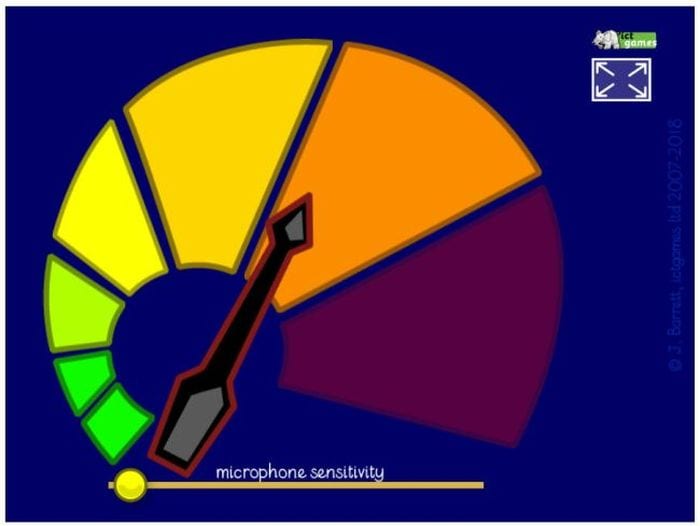
How it works: This simple noise level meter shows noise levels from green (good) to red (bad). The only setting you need to worry about is the microphone sensitivity. The meter starts automatically, so you’ll just need to adjust the microphone sensitivity as necessary.
Cool features: Calm Counter doesn’t have any fancy bells and whistles, and that can be a good thing. It’s extremely easy to use and the visual display makes it simple for kids to see when they’re being too noisy.
Try it: Calm Counter
2. Classcraft Classroom Noise Level Meter
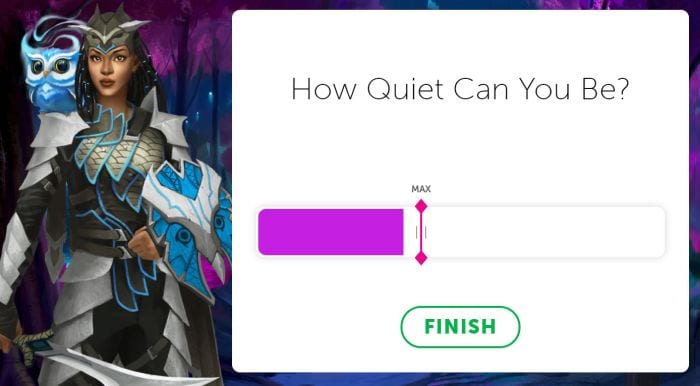
How it works: A volume meter appears on the screen, changing to reflect the amount of noise in the classroom. If the noise crosses the max line, a pop-up on the screen states that you’ve been too loud. There’s no audible alert, only the visual warning. To get started, click “Try Now,” set the timer (or click the X button to skip it), set your max volume, and click Start.
Cool features: You can set a timer at the beginning if you like, turning this into a game to see if you can find the buried treasure without any noise violations.
Try it: Classcraft
3. Zero Noise Classroom by Google Chrome
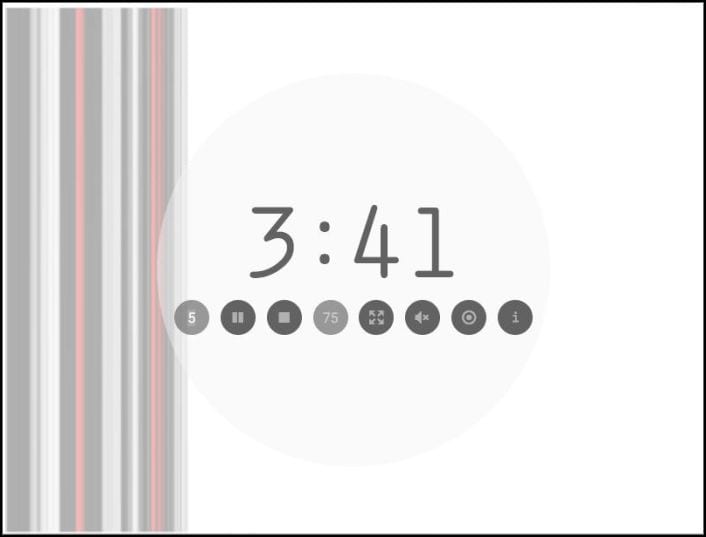
How it works: This classroom noise monitor is a Chrome extension that displays current sound levels in the background as it runs. Light shades indicate quiet, while darker gray means the classroom has gotten louder. When a red stripe displays, it means the noise has passed the maximum level (there’s no audible alert).
Cool features: Because this classroom noise monitor displays the “noise history” from start to finish, it’s a fun way to see just how often a class is passing the “noisy” threshold. Try it as a challenge: If a class can finish 30 minutes of group work without hitting the red a single time, they earn a prize.
Try it: Zero Noise Classroom
4. Too Noisy Lite
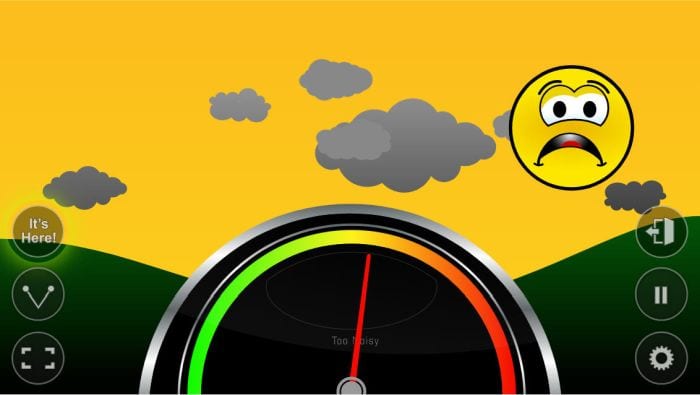
How it works: The noise meter at the bottom is reflected in the color of the sky and the emoji above. It changes from happy blue sky to dark clouds as the noise increases. Register with EdTech Monster to receive free access to Too Noisy Lite. Once you’re signed in, the meter starts automatically. We recommend using the Calibrate button in the Microphone settings menu for best results.
Cool features: The free version of this classroom noise monitor app is simple and effective. If you’d like to activate more features, you can download the paid version on your phone or tablet. The online Pro version has plenty of extras for a monthly fee.
Try it: Too Noisy App
5. Class Dojo Noise Meter
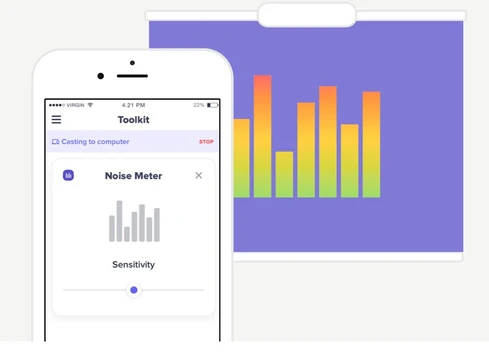
How it works: Class Dojo’s Noise Meter helps remind students what the appropriate volume should be in the classroom at specific times. The columns of the bar graph change in size and turn from green to yellow to red when the volume starts getting too high.
Cool features: The Noise Meter is simple to use, with customizable microphone sensitivity, fun animations, and remote control via your phone.
Try it: Log in to your ClassDojo account and click on Toolkit. Then select Noise Meter.
6. Noise’O’Meter
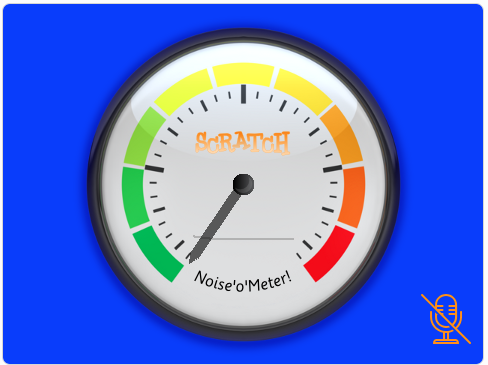
How it works: This is basically a coding project created using the popular coding platform Scratch. To start using Noise’O’Meter, you need to turn on your computer’s microphone. Noise’O’Meter takes the shape of a clock with a single hand that moves clockwise according to the noise level. The tool uses a color-intensity system to tag noise levels, starting with low levels (green) all the way to highest noise levels (red).
Cool features: Since Scratch is a collaborative community-based coding platform, members of the community have used Noise’O’Meter in their own projects creating what is known in Scratch lingo as Remixes. You can find these remixed projects on the right-hand side within the tool’s home page.
Try it: Noise’O’Meter
7. Bouncy Balls
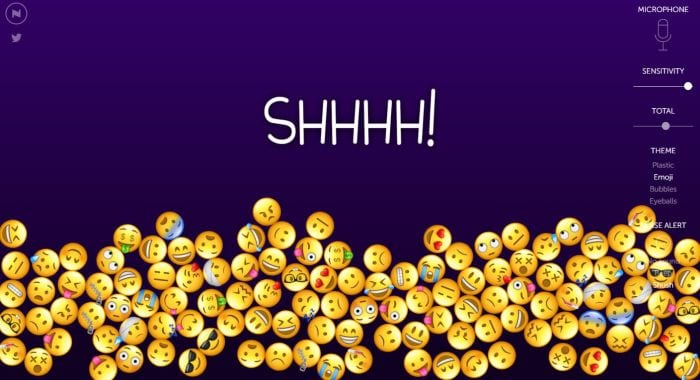
How it works: The louder the classroom, the higher the balls fly! The goal is to keep the balls hanging out at the bottom. When the noise level rises too high, the program will alert students with a “Shh!” or loud beep—you choose.
Cool features: You can change the balls to bubbles, emojis, or even eyeballs! This is also the only free classroom noise meter that has an audible alarm when kids pass the noise threshold.
Try it: Bouncy Balls
Best Physical Noise Meters
Choosing a physical noise meter over a virtual one has some benefits. While you will need to pay for one, one of the biggest perks is that they provide a real, visual cue for students in the classroom. You also won’t need to worry about having access to the Internet or needing a power source (if you choose a model that’s chargeable or battery-operated).
8. Decibel Meter Wall-Hanging Sound Level Meter
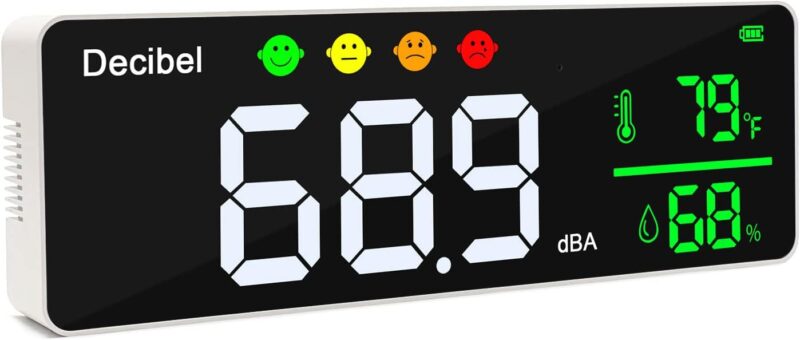
How it works: Keep an eye on classroom noise levels with this cool monitor that features a large, easy-to-read LED display. The screen shows real-time noise levels along with helpful temperature and humidity readings. The display brightness can be adjusted to meet your needs and the cute faces will let you know if it’s getting too loud in your room.
Cool features: While it’s built to be both precise and practical, it’s easy to recalibrate if the readings ever seem off. You can put it on a desk or mount it on a wall to make it easy for everyone to see. It comes with a long USB cable, so it’s also easy to charge! Amazon reviewer and teacher Alyssa K Osayande says, “I bought this for my classroom because I found myself having to yell over the kids this helped so much!”
Buy it: Decibel Meter Wall Hanging Sound Level Meter
9. Yacker Tracker Noise Detector
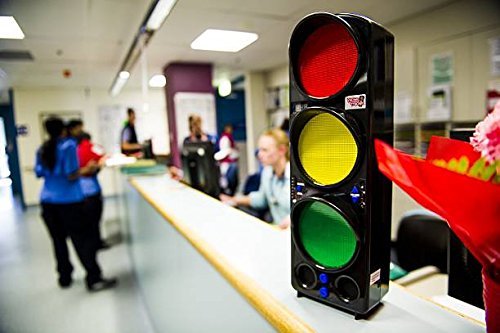
How it works: Imagine a traffic light that doesn’t just control cars but controls noise too! The Yacker Tracker is just that—a clever device designed to monitor sound levels wherever peace and quiet is needed. Simply set your desired noise limit and let the Yacker Tracker do the rest. When things get too loud, it’ll flash and sound an alarm, giving everyone a clear, immediate signal to lower their voices.
Cool features: The visual and audio alerts are easy for kids of all ages to understand. Plus, it looks like a real traffic signal, making it a fun yet authoritative presence in any room. Amazon reviewer and art teacher Troy says, “It’s honestly helped me a lot so far. Just make sure you have clear rules about it to your students bc they WILL try to set it off on purpose to be silly and play around.”
Buy it: Yacker Tracker
10. Wall-Hanging Sound Level Meter
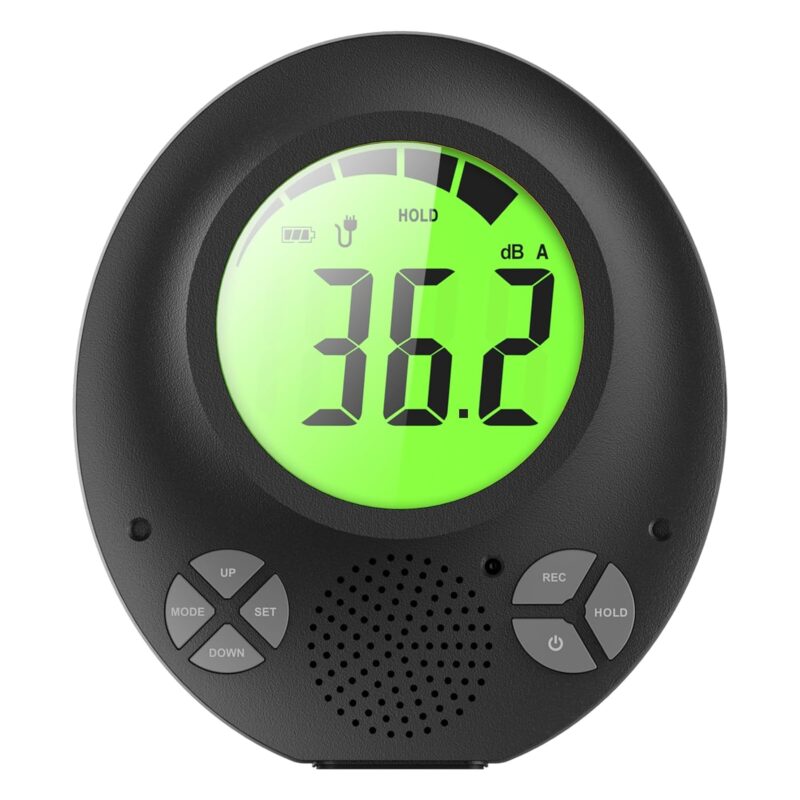
How it works: Keep your learning space comfortable with this low-profile, highly accurate sound-level meter. When things get too loud, the meter politely reminds everyone to quiet down with a spoken “Quiet, please” alert. Plus, you have the option to customize the alarm threshold to suit the specific needs of your classroom.
Cool features: This decibel meter is designed for convenience and ease of use. You can use an AC adapter or 6 AA batteries (included), place it on a desk or mount it on a wall, and the backlit LCD digital display makes it easy to read in low-light conditions. T Dawg on Amazon says, “I need to save my voice for teaching so having a non-verbal indicator I can point or gesture to, in addition to a warning it gives off itself, is phenomenal. This meter is portable and comes with everything you need to operate it.”
Buy it: Wall-Hanging Sound-Level Meter
11. SW-525A Sound Level Meter
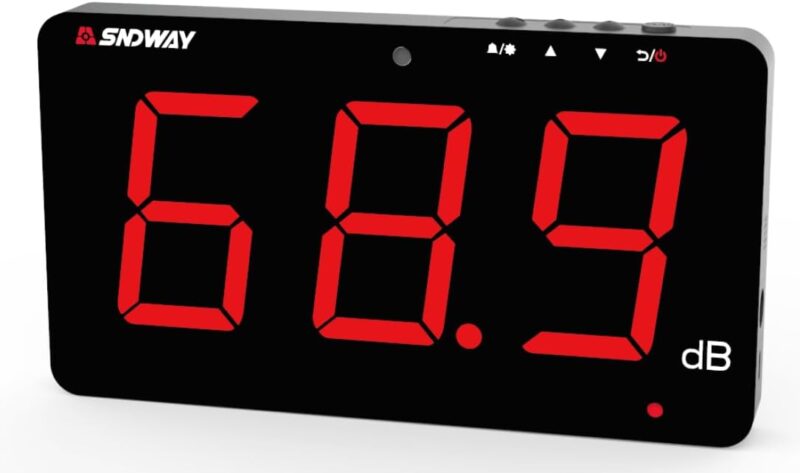
How it works: This no-frills sound-level meter can be used indoors or outdoors and features a built-in alarm system consisting of a blinking indicator light and buzzer to alert you when noise levels exceed your set limits. It is powered by a DC 5V 1A Type-C USB cable and does not contain a battery (this is a common issue, so be sure to check if you have a compatible USB socket available before buying!).
Cool features: The large LCD display is easy to read, the monitor responds quickly to changes in the environment, producing true real-time sound levels, and the handy hanging holes make it easy to mount it on a wall. BurntSienna on Amazon says, “I got this so they could see for themselves as their volume increases. We set the alert fairly low at 85 decibels and it helps them to have an objective measure of their volume that is consistent, quick, and automatic. It’s wonderful.”
Buy it: SW-525A Sound Level Meter
12. Digital Sound Level Meter
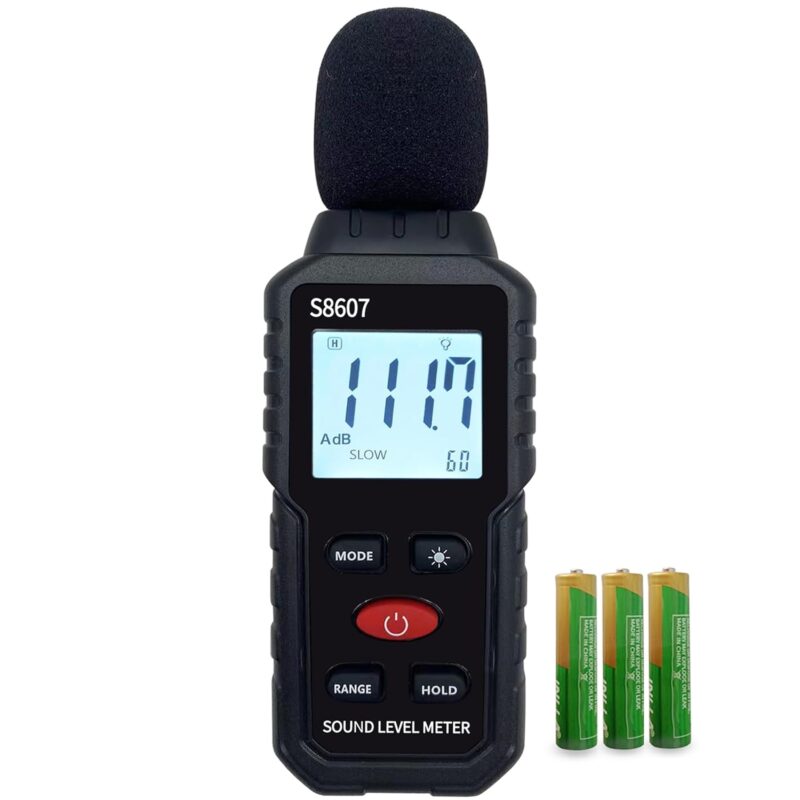
How it works: It might look a bit like a walkie-talkie, but this noise meter delivers precise sound level measurements and it’s easy to use! The Mode key allows you to quickly switch between Fast or Slow response times, while the Range key allows you to monitor the highest and lowest noise levels. This is a great choice if you just want something simple and affordable for your classroom.
Cool features: This noise monitor is equipped with a large LCD that includes a backlight for clear visibility in darker conditions. It offers customizable alerts and signals when noise levels exceed your predefined settings, ensuring you always have control over your acoustic environment. The automatic shutdown feature conserves power, making the device efficient and dependable for long-term use. Teacher Negadelphia says on Amazon, “Needed something to test noise levels in my gym during classes. This was the perfect meter.”
Buy it: Digital Sound Level Meter

